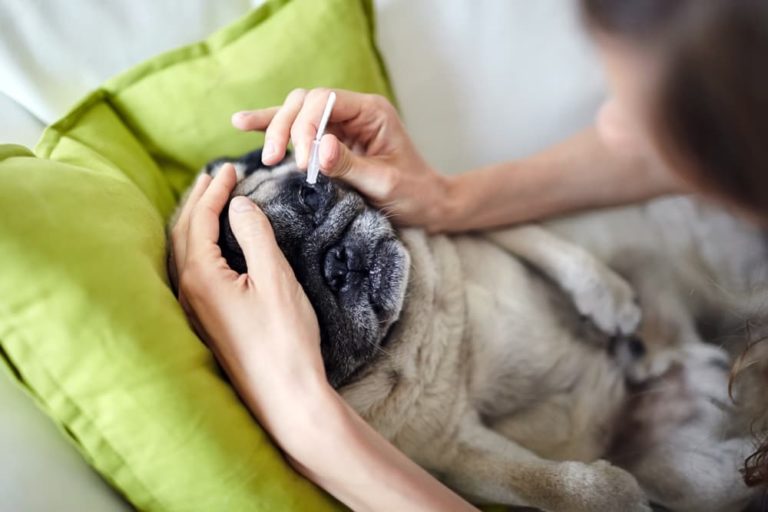Eye Drops for Dogs: Types and How to Use Them

Squinting, blinking, thick discharge, excess tear production, swelling, redness, and pawing or rubbing at the area are all signs your dog likely has irritated eyes.
Like humans, dogs can experience a range of issues that impact their eyes, from dry eye and allergies to glaucoma and infections. Eye drops are one of the most common treatments for these types of dog eye problems.
Eye Drops for Dogs: Why Your Dog Might Need Them

Your veterinarian may suggest eye drops to treat a variety of conditions, according to Dr. Terri L. Baldwin, veterinary ophthalmologist at BluePearl Veterinary Partners in Clearwater, Florida. Let’s go over some of the more common eye conditions that may require eye drops.
Dry Eye
An autoimmune disease, keratoconjunctivitis sicca (AKA dry eye) causes decreased tear production that dries out the eyes. Tears provide essential lubrication to the eyes, and without tears, dogs can experience redness and irritation and ultimately blindness.
“Medicated eye drops are necessary to stop the autoimmune attack on the lacrimal [tear] gland so that the tear gland can produce tears normally on its own,” Baldwin explains. “Until the tear numbers are normal, artificial tears are used to replace the tear film and lubricate the eye.”
Eye Infections
Bacteria, viruses, and fungi can cause dog eye infections that lead to symptoms like redness, swelling, yellow or green discharge, light sensitivity, and squinting. In cases like this, Baldwin says dog eye infection drops prescribed by a veterinarian are necessary and “may need to be applied as often as hourly to eliminate the infection.”
Allergies
Your pup can be allergic to anything from pollen to certain foods, and two different kinds of allergy eye drops for dogs are used to treat symptoms like itching, redness, swelling, and excessive tearing.
According to Baldwin, antihistamine eye drops interfere with the cellular response to pollen and allergens to prevent allergic inflammation, while topical anti-inflammatory eye drops – including both nonsteroidal anti-inflammatory and steroidal anti-inflammatory medications – reduce inflammation.
Glaucoma
Glaucoma increases the pressure in the eye, causing pain, watery discharge, and swelling in the eyeball. Without treatment, glaucoma can also lead to blindness. Baldwin explains that eye drops help reduce the amount of fluid produced inside the eye or increase the outflow of fluid from the eye.
Eye Drop Frequency for Dogs
When it comes to how long you’ll need to administer eye drops for, it really depends on the issue. For an acute condition like an infection, your dog may only need eye drops for a short period of time. Chronic conditions like allergies, dry eye, and glaucoma may require ongoing eye drop treatment to help alleviate symptoms.
Types of Eye Drops for Dogs

There are a number of different eye drops available to treat canine eye issues. These include:
- Antimicrobials (antibiotics, antifungals, antivirals)
- Steroids
- Non-steroidal anti-inflammatories
- Immunosuppressants
- Tear stimulants
- Tear replacers
- Hypertonic saline
Almost all of these eye drops are only available with a prescription. Baldwin notes that while over-the-counter eye drops for dogs do exist, it’s rare to use them to treat dogs.
How to Use Dog Eye Drops

The directions for dog eye drops will vary depending on the medication and issue, but Baldwin offers some general guidelines for the effective use of eye drops for dogs.
Wait five minutes in between drops. The eye absorbs 95 percent of the medication in the first five minutes after drops are given. If dogs need multiple drops, wait five minutes to let the first drop absorb before giving the second drop.
Do not touch the applicator to the eye. This helps keep the applicator tip clean, prevents the spread of infection, and eliminates the risk of injury.
Check the expiration date. You should never give your pet expired medications, including eye drops.
Precautions When Using Dog Eye Drops
As with all prescription medications, Baldwin stresses the importance of using eye drops for dogs as directed — and once you start using them, monitor your dog for any side effects. If the symptoms worsen or don’t improve, call your veterinarian for a recheck.
In multi-dog households, establish a “paws off” rule when it comes to sharing dog eye drops. It’s possible for the dropper to pass infections between dogs, so each pup should have their own eye drops.
Can You Use Human Eye Drops on Dogs?

Yes! “Most of the medications we use on dogs are human eye drops,” Baldwin says. “Very few are actually made specifically for dogs.”
However, it’s important to note that you should only use human eye drops for dogs when instructed by your veterinarian. Do not assume it’s safe to purchase over-the-counter eye drops for your dog at the drugstore.
Baldwin explains that there are some human eye drops that can cause systemic side effects in dogs, so it’s crucial to only use ones that have been prescribed to your pet specifically.
Best Prescription Eye Drops for Dogs
Because every eye issue (and every dog) is different, your veterinarian is the best resource for learning about the eye drops that are best for your dog. If over-the-counter drops will suffice, they’ll let you know. However, some eye issues call for prescription drops, like Ofloxacin Ophthalmic Solution 0.3%.

Veterinarians may prescribe Ofloxacin (also sold under the name Ocuflox) to treat bacterial infections or corneal ulcers. These eye drops are FDA-approved for humans and used “off-label” in veterinary medicine. You need a prescription from your veterinarian for these drops.
Pros
- Fast acting
- Sterile ophthalmic solution is easy to administer
- Clears bacterial eye infections and alleviates symptoms like pain, swelling, and itching
Cons
- Only used to treat bacterial infections; ineffective for other eye conditions
- Must be used under veterinary supervision
- Should be stored at room temperature









